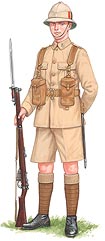Security
 |
| Corporal, 1st Bn The East Surrey Regiment c 1922 (India) (Click to enlarge) |
Exceptional care was taken of the security of arms and ammunition as every weapon stolen could be used by tribesmen against our own soldiers, and Northern India abounded with skilled rifle thieves. Each company barrack room had a rifle rack in the centre of the room to which weapons were padlocked when not in use. At night two orderlies slept either side of the rack, rooms were visited by the Orderly Officer and the weapons were counted. By day one orderly was always on duty in each room to safeguard weapons and equipment while men were away on training. After shooting on the rifle ranges every round and empty case had to be accounted for, and the men’s pouches inspected by an officer. The loss of a rifle in India was accounted a major disgrace on the part of the unit.
 |
| Private, 1st Bn The East Surrey Regiment c1937 (Click to enlarge) |
Weapons and ammunition were carried on church parades in 1931, a precaution dating back to the outbreak of the Mutiny at Meerut during morning service on Sunday 10th March 1857. Old suspicions died hard.
The primary role being internal security when not deployed on the North West Frontier much training time was devoted to this, and demonstrations were given to show how the military should take over from the Indian Police on the authority of the local magistrate when rioting got out of hand. This seldom happened but when it did the presence of well turned out and highly disciplined British troops was salutary. Separation of troops from rioters was a fundamental feature of internal security training, and internal security drills for crowd dispersal were clearly laid down in the 1930s. They were based on a platoon of some thirty men. The platoon formed up smartly with, if possible, a wire barrier between it and the mob, and with a diarist and photographer to record events, a banner inscribed in English and the vernacular calling on the crowd to disperse, which would be raised when required, and a bugler to draw attention to it. First there was the formal signing over of responsibility for dealing with the situation to the military commander by the local magistrate or police officer, then the warning to disperse, and finally, should that be necessary, the opening of carefully controlled fire by specified marksmen at identified agitators followed by a pause to assess the effect and provide the opportunity for the mob to disperse.
Related
